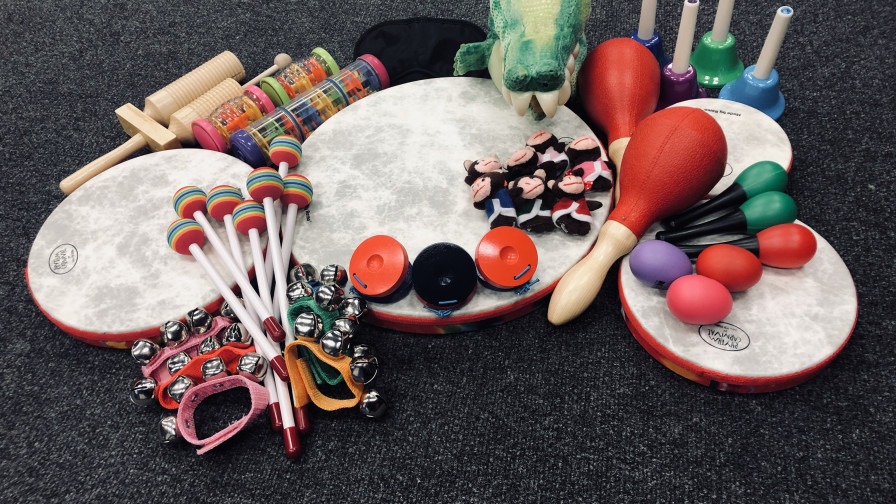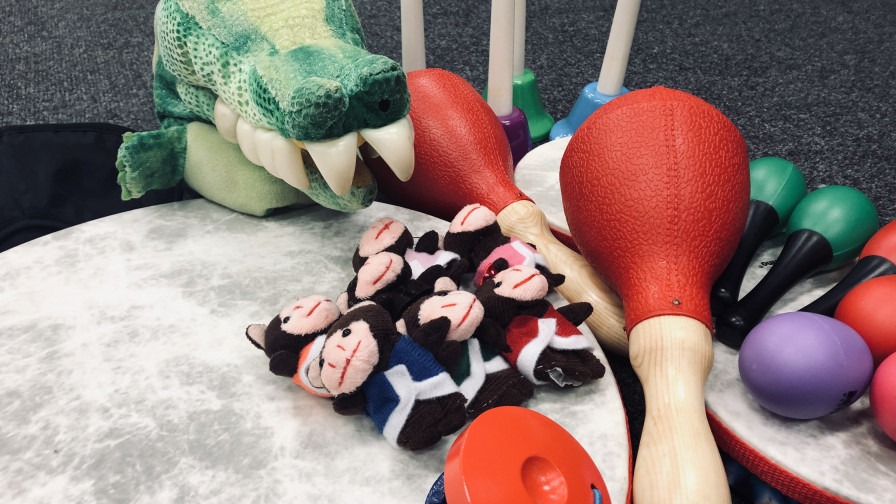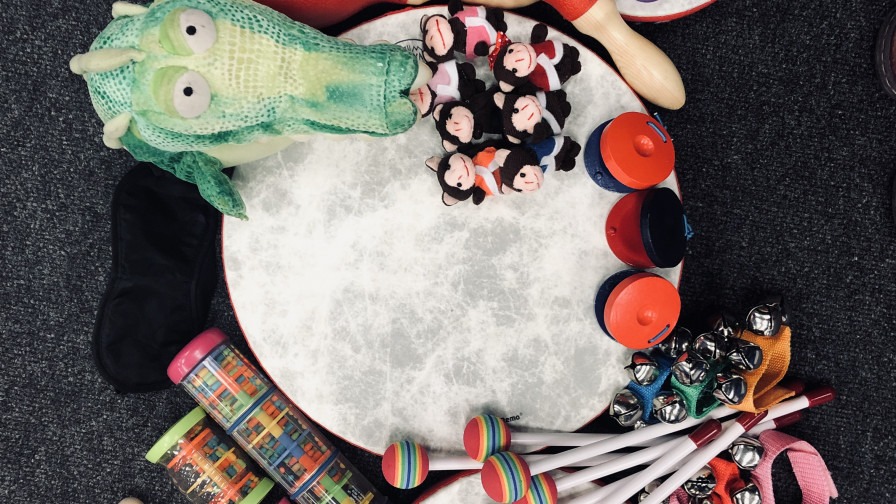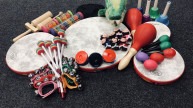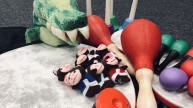An Early Years Conversation - The Whole Picture
Between September 2018 and the current term (Summer 2019), Plymouth Music Zone has been delivering weekly sessions in three Early Years settings across the city as part of its Youth Music funded programme of activity in Plymouth, Devon. The delivery comprises 4hours per week with two music leaders - Holly Bench and Josie Newton who, alongside myself had lengthly honest 'warts and all' conversations about their work, the challenges and opportunities, their ideas, developments and reflections. We wanted to share it with other practitioners who may wish to comment / add / challenge on the network and potentially build on these themes as part of a wider conversation.
As part of Plymouth Music Zone's music leader training support 'hub', our team can meet as peers support to discuss specific areas of work. This post aims to distill the main areas of discussion...
Session Durations are as follows (primarily scheduled by the settings themselves):
- 2 groups in one setting (rising 3's and Foundation Stage) which are split into 20-25mins / 30mins
- 45mins / 1hr with each pre-school / nursery group
The main contrast between the three settings are the size i.e. within a large mainstream primary school or separate facilities. Some of the bigger groups have presented different kinds of challenges, such as different levels of concentration, variable staff support, challenging behaviours, and some children who have been intimidated by being in larger groups.
In all the settings, the children are now brought to the music session in a focused, regular group with numbers that can be anticipated by the music leaders. This has settled after an initial period when other groups sometimes were brought in, which was difficult to manage.
All the sessions include support staff, but this is highly variable. For example, in one of the larger groups, there are three support staff for 20-25 children. In another group of 14 children, there is one TA to support these children who are aged 3 and under.
One music leader described when she was asked to work with a group of 39 children with one member of staff supporting. In a Foundation class, she also described working with up to 25 children, sometimes with one support assistant, sometimes no support at all, but with a teacher ‘hovering’ nearby. Some children in this group were already working to writing targets and removed from the sessions (e.g. 5 children removed to work on a writing activity in the middle of their music session). Obviously this was very disruptive and the music leader felt it was disrespectful to her input, as well as the children themselves who had been enjoying it. It also highlighted the pressure that is already being placed on the teachers / children at this early stage of learning to work to literacy and other targets that are prioritised over music and other learning activities.
By contrast, in the pre-schools, music leaders said there were 2-3 staff plus any placement students for a group of 10 – 15 children, again, some with additional needs who require one:one support.
It’s clear through these discussions that the music leaders have had a lot of different challenges aside from the actual delivery of activities and materials. That said, this has all brought about learning opportunities and an openness to talk about what this means in terms of quality delivery. All the settings are located in Plymouth in areas described by others as socially and economically deprived, although within these catchment areas this is highly variable due to development and investment as well as complex economic ‘pictures’ within them.
Session Content
- Action and Counting Songs for supporting communication are very useful, particularly for children with language and developmental needs. Counting up and down with fingers is often used for anticipation, repetition and building on a theme. Building expression into these actions is important in terms of progression e.g. using accents and emphasis with hands, making bigger gestures to emphasis important points and musically this is important too. Examples include “5 Little Monkeys” and “Mr Crocodile” songs, where we make obvious use of dynamics and anticipation
- Makaton Signing is used in some songs as well as actions. (One Music Leader is also BSL trained)
- EAL (mainly children from Poland) were learning nursery rhymes even when a little older (around 5) and this was helpful for language development as well as connecting with one another and recognising characters and stories around the classroom and toys
General Comments - things that impact the sessions
- Music Leader / School Staff Identities are acknowledged by using music Leaders’ first names, e.g. “I’m Holly”. The children understand there’s a difference between music leaders and teachers / EYFS workers.
- Offering choice is really important, but we never insist that children have to take part in led activities, or having to make a decision in front of others if it causes them any sort of distress. We offer space and time wherever possible for them to make this decision.
- Praise and rewards can be received in very different ways. It’s important to pick the right moment as some children don’t react well to praise in front of others. Rewards have to be consistent and fair.
- Leading with different instruments: Josie mainly leads with Guitar accompaniment. Holly uses Saxophone, but obviously not in the singing activities! She said that children allowed to experiment with the keys, but H would blow it for them (germ control!). The children love getting opportunities to explore these instruments and Josie also makes a chance to explore her Guitar part of her sessions. Some children want to strum it for themselves with Josie helping with chord shapes, others wanting to put their ears / faces onto the body of the Guitar or look inside it whilst listening and enjoying the vibration of the instrument.The group routine of taking in turns strumming the Guitar allows young children to experience an instrument with support, but they can explore it with a level of independence. This also has given L and J an opportunity to show natural rhythm and excellent timing.
- Musical Skills: Groups have explored dynamics, tempo, playing to a steady beat and playing musical cues along to a story book / song.
Interaction and promoting a safe musical environment
- Laughing with the children – using humour is really important and having fun when making music together
- Consistency – it helps to have repetition as well as tools that help the children connect with the music leaders
- Choice is really important e.g. ‘Hiding Under the Covers’ song when the children can talk about and choose what emotions they feel that day as they hide themselves under a blanket then re-emerge saying (or showing using a sign or action) how they feel. Choosing instruments can work fine with the smaller groups, but can be more difficult in the larger ones. When limited with time and instruments this can more of a challenge. However, when it is working well we witness sharing, encouraging one another, exploring shapes, colours and sounds etc.
- Staff Confidence: There are some interesting reactions from some staff around 'noise' and what music making is to them (e.g. their own confidence to sing and model for the children themselves taking part). Music Leaders encourage staff to enjoy themselves in the sessions also, gradually building them up if they are less confident in themselves. This has a wider impact on how much they are able to 'let go' so the children can explore the instruments without fear of them getting broken or being too loud, or being played in the 'proper way'.
- Helping Each Other: In one music leader's sessions, children hand the instruments out in little bags and get involved in the distribution / choosing instruments (H). ‘Helpers’ are chosen and this is combined with knowing the name of the instruments to return them to the bags – introducing etiquette and caring for the instruments too. The 'Pack away game' is bit like musical statues until all instruments put away. Or Sleeping Dragons…to pack away suitcase of instruments.
Social / Interactions and Observations
Some twins in one of the settings started a ‘hugs’ tradition at the end of session ‘hug or high-five’. This apparently started following a viral video online showed how children were welcomed into class in a South American school: ‘wave, hug, high five or hug’. This presented a tricky situation to navigate – in two sessions this was encouraged by the setting – always initiated by the children. Some children just wanted to say goodbye. In the settings in some of the most deprived areas, this part of the session is extremely important to the children. In other sessions this is not seen as appropriate.
There’s a massive variation in children’s wellbeing and apparent care. For example, Josie described one child with broken and badly fitting shoes that were never replaced, whereas, by contrast others arrived with expensive clothes and shoes. In some of the settings it was clear that the children craved more hugs!
In one of the settings, the children already know they aren’t allowed to sit on adults’ laps or knees. In some of the smaller settings with younger children this was not the case. The music leaders said it was about keeping boundaries but ensuring that the children weren't isolated from them.
Examples of interactions:
- The children welcome the music leaders, clearly valuing and looking forward to spending time with them.
- J now gets excited at the start, using hand signals independently (for songs and to lead the conducting game).
- K is now able to concentrate for the whole session and now sings melodies to all the songs, with and without words.
Confidence
- Both music leaders described that it was helpful not to be afraid to repeat things to boost the children’s (and staff) confidence.
- The music leaders use different repertoire and activities for the very young children.
- Music leader confidence improves when settings share stories about impact outside sessions, as well as opportunities to talk to one another about their work.
Examples of building confidence:
- P is very shy and quiet and needs lots of encouragement and support to be fully involved in activities. P is still quiet but now puts her hand up to volunteer and ask to choose or lead.
- L has found her voice, singing clearly, answering questions correctly and saying ‘Hello Josie’ clearly
- R spent many sessions with parent present and was unable to engage. He is now independent and sings all the songs, asks to help set up and clearly says ‘Hello Josie’.
Examples of Developing Independence:
- Choice-making with song cards and which instruments they would like to play & what emotion / animal / action we do for a song.
- K was never positive in our group and would not want to sing or choose a song card, but would always use an instrument. The group (staff included) never forced him to join and respected his space as he never disrupted the session. Recently he volunteered to use the Mr Crocodile puppet for a song and did so with a smile.
Challenges across the work...
- Timetabling: Different school / setting timetables mean that the sessions are all run very differently with different levels of disruptions and different levels of energy within the group depending on the time of the session.
- Time / duration is a leading factor, particularly when it’s not always possible for all children to try things in the larger groups or have freer exploration without ensuing chaos! It’s also less meaningful in terms of being able to observe individual development.
- Class / group sizes are very important to successful delivery. Unexpectedly high numbers of children being brought into sessions who were not in the originally organised group without an option to say no to working with so many children was a huge challenge. Music leaders had to negotiate group size numbers with one of the settings to improve quality of engagement. The groups have between 14 and 39 (rising 3’s and 3’s). Groups split into more manageable sizes and durations.
- Individual focus - person-led approach: Having one to one interactions within the group setting is really important. E.g. when 25 children are in a foundation group, how can this be made possible? Both music leaders try to make time for the more withdrawn / shy children. It’s a big challenge to work in this way, but we try to use circle time to do this e.g. one child leads from drum (name “my name is…”) and rest of the group repeats afterwards.
- Inclusion: Finding ways to best support developmentally delayed children or those with additional physical, learning or sensory needs
- Information Sharing: Music leaders understand that it isn't always possible to have information about background and reasons behind particular behaviours prior to leading sessions, but sometime this would be helpful so they can approach their sessions in a considered way.
- Partnership working: Lack of consistency of support - i.e. too little or too much (!) staff support as well as overall understanding of the value of the sessions and observing the children in the activities
- Consistency: Huge variety of behaviour, expectations and support across the settings.
- EAL: We have used different ways to support children with English as an additional language, but would always want to do more, perhaps exploring other musical cultures and songs in other languages?
- Space: Managing spaces and resources effectively has been challenging, especially when spaces have been too small for the numbers of children in the room.
- Resources: Spreading resources thinly has been necessary when groups have been too large, which restricts choice and is not ideal.
- Music Leader Accessibility: Working to communicate and accommodate personal challenges in terms of physical accessibility of settings as music leaders living with chronic illness / disability.
- Forces families: there are a high proportion of families where the sessions are located where one or both parents are in the armed forces. This can bring additional challenges to the children (and families) lives, such as associated behaviour / attachment issues and living with uncertainty and disruption at home.
Instruments, Resources and Materials
- Space is really important. It can cause distraction or provide focus, it can comfort or destabilise etc. There’s only so much we can do when using someone else’s space, but generally if there’s room to work in a circle, that’s for the best.
- Choosing cards are used to help children connect songs and activities with instrument names, keywords and pictures. The visual aspect can help children who need to have more structure to feel safe about what will ‘happen next’ as well as make choices and connections. The repetition of this offer seems to have been helpful in all the settings, particularly when there’s only a relatively short time to be with one another each week.
- Using Resources Differently: Holly strings bells together to form a 'bell snake' (Velcro fastenings) and the children are asked to pass it around the circle without making a sound. The children love this and it emphasises the importance of silence in music as well as making sound. It also extends the original use of a single set of bells.
- School Behaviour Charts: Some sessions have asked the leaders to link into their school / setting rewards system e.g. behaviour chart but also acknowledges which children have behaved well in the music session and try to make sure that all children are acknowledged at different times to improve their confidence. Music leaders had mixed ideas on this as they didn’t want their sessions to be associated with negativity if attached to behaviour rewards systems.
- Well behaved children are often ignored and music leaders were both aware that they would want to ensure that these children felt good about themselves too.
- Improved Resources: PMZ invested in an updated range of instruments appropriate for early years settings
- Adapting Songs: Music leaders often change and adapt songs to ensure they are appropriate e.g. What Shall We do with a Pirate Sailor (instead of Drunken). Music leaders also talked about their awareness of gender bias in songs and aimed to address this balance across their repertoire.
Opportunities
- Exploring different ways for children to access instruments and songs, including use of signing, music technology and selecting appropriate instruments for the age group
- Tracking progress of individuals and sharing with school staff as well as meaningful PMZ reporting and project evaluations has proven the impact of the work and strengthened partnerships with the settings. This includes sharing observations that clearly link to the EYFS and supporting preschool staff to spot ‘how’ musically and socially the children are developing in music sessions specifically.
- Intergenerational opportunities present themselves in terms of Plymouth Music Zone annual events as well as similarities and differences between different types of music leader delivery across the ages – i.e. what’s important across all of this work?
Questions
How can we balance ‘led’ activities with children’s own exploration alongside behavioural and other expectations of the different settings (i.e. working alongside the staff to navigate this), particularly when working with larger groups of preschool age children?
How do other people get feedback about impact of music sessions on the children either at school or at home?
Music Leader Support
Both music leaders talked about occasional feelings of isolation in their work. They said that despite this, they enjoy the work, focusing on what they are doing and being very present with the children so it doesn’t always feel like that and that they knew they could come into PMZ at any time to talk to the team.
Plymouth Music Zone offers support to music leaders in terms of snapshot observations and a regular supervision process. Music leaders are offered time and space to share practice ideas, talk through challenges and potential solutions together and to keep aware of other ways that people are working in Early Years music making. The organisation is continuing to explore partnerships and other delivery across the city of Plymouth whilst balancing its programme of Early Years work with its intergenerational programme offering participative music making activities for people of all ages. (The current oldest participant is 104!).
Youth Music’s quality framework for Early Years settings is helpful to organisations and individuals wishing to reflect on their practice and delivery. Every setting is different, as are the approaches of every leader / educator and Plymouth Music Zone is continue to reflect and develop its work across all its different projects.
https://network.youthmusic.org.uk/file/38562/download?token=Qfbib1cR
From the Source...
As part of my role at Plymouth Music Zone as Creativity and Learning Director, I offer snapshot observations as a supportive way of being a critical friend to our team. The most striking things for me overall in a session I observed at one of the Pre-schools was the depth and length of engagement with such young children. Their behaviour was outstanding and yet there was freedom of choice and fun built in at every level of the session. I did not feel that the children were being constricted during the activities, but that Josie had gently but clearly set up her expectations and she had the absolute support and understanding of the staff as well as the children and this made for a fantastic partnership. It was clear Josie knew the children really well and was keen to make sure that the less confident children got to be as involved as they felt comfortable to be too. They loved her musicality and singing voice and a 'proper musician' being in the room with them.
And to finish….direct feedback shared by staff in one of our Early Years settings:
Rachel Clancy (Early Years Practitioner) said the following:
"The children had been singing the “Pirate” song that morning together unprompted before Josie came to do music. This shows they use music from the sessions in their play. The staff are starting to spot these links and I think they also get more confident doing music activities.
The children will run and sit down ready if they hear the doorbell and they think it’s Josie. We love Josie – the kids really do. So much of the music crosses over with the EYFS curriculum and helps us with how we implement it. The children also do extra activities based on the songs and things. For example, the children made masks for the Pirate Songs. We have a basket of instruments and song cards too. The children like using these. We also do something where we hide the instruments behind something and the children have to match the sound with a card.
We noticed one child who has glue-ear and speech difficulties is responding really well to the sessions. After Josie has gone, we have noticed him modelling Josie’s behaviour to make friends.
Songs like Alice the Camel and maths-based ones like that really help. There are so many links with the curriculum that are met all at the same time. E.g. PSED (Personal Social Emotional Development), Literacy, Maths, Physical development, understanding the world and communication and language. The emotions-type songs help the children understand their feelings and describe them – happy and sad and that it’s ok to feel different ways and you can tell people.”

